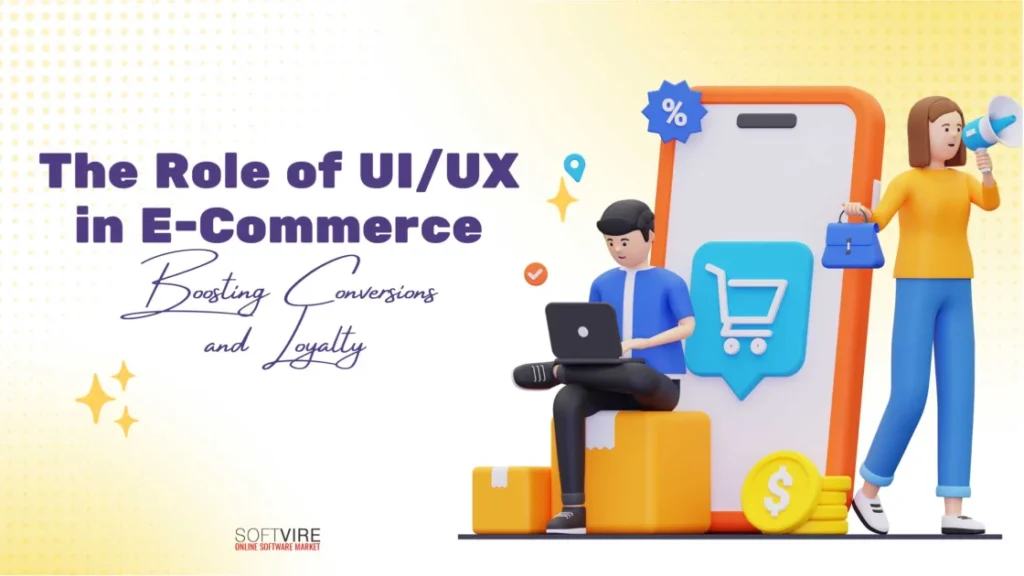The role of UI/UX, the user interface, and user experience design in e-commerce is pivotal, shaping the digital landscape of online shopping and significantly impacting the success of businesses in the digital realm. UI/UX isn’t just about aesthetics; it’s a strategic approach that profoundly influences how users interact with e-commerce platforms. This dynamic pair is essential in boosting conversions, as a well-designed and user-friendly interface can captivate visitors, guide them seamlessly through the shopping journey, and ultimately lead to more purchases. Moreover, a positive user experience fosters customer loyalty, transforming one-time buyers into repeat customers and advocates. In this digital age, understanding the significance of UI/UX is essential for e-commerce businesses striving to thrive and outshine the competition.
User Interface (UI) and User Experience (UX) design in e-commerce is paramount in boosting conversions and customer loyalty. Here’s a detailed look at how they contribute to the success of e-commerce platforms:
- First Impressions Matter: A well-designed UI captures the user’s attention and creates a positive first impression. It should be visually appealing and have an easy-to-use interface, straightforward navigation, and high-quality images, which can help a potential customer stay and explore the website.
- User-Friendly Navigation: A well-thought-out UX ensures the website is easy to navigate. Customers should be able to find products, browse categories, and check out effortlessly. Clear and concise menus, search functionality, and filters for products all play a role in creating a user-friendly experience.
- Mobile Responsiveness: With the growing use of smartphones, a mobile-responsive design is crucial. A good UI/UX design ensures that the website looks and works effectively on various devices, making it convenient for customers to shop from anywhere.
- Page Load Speed: Slow-loading pages can deter customers. An optimized UI and UX contribute to faster loading times, essential for retaining the user’s interest and driving conversions.
- Trust and Credibility: A professional and well-designed e-commerce website instills trust and credibility. Elements like high-quality product images, clear product descriptions, and secure payment options contribute to a positive user experience and boost customer trust.
- Streamlined Checkout Process: A critical factor in e-commerce success is a streamlined checkout process. An excellent UX ensures that the checkout process is as straightforward as possible, with minimal steps and clear calls to action. Complicated checkouts can lead to cart abandonment.
- Personalization: Personalization in UI/UX design involves showing products or content tailored to the user’s preferences and past behavior. This enhances the user’s shopping experience, making them more likely to find items they want and boosting the chances of conversion.
- Product Recommendations: UI/UX design can include intelligent product recommendation systems. When done right, these recommendations can increase average order value and customer loyalty by suggesting relevant products that customers may not have otherwise found.
- Customer Reviews and Social Proof: A well-designed UI/UX should make it easy for customers to leave reviews and read others’ experiences. Positive reviews and social proof are crucial in boosting trust and influencing purchasing decisions.
- Customer Support: A good e-commerce platform should offer easily accessible customer support. A well-designed UI/UX can include chatbots, contact forms, or clear instructions on how to get help when needed. This contributes to customer satisfaction and loyalty.
- Performance Analytics: A great UI/UX should incorporate analytics tools to track user behavior, identify pain points, and improve the shopping experience continually. Data-driven improvements can lead to better conversions and loyalty over time.
- A/B Testing: UI/UX design allows for A/B testing, which enables e-commerce businesses to experiment with different design elements to determine which ones are more effective in driving conversions. This iterative approach can lead to continuous improvements.
Here are some additional points on the role of UI/UX in e-commerce, particularly in boosting conversions and loyalty:
- Feedback Loops: A well-designed UI/UX includes mechanisms for collecting feedback from customers. This feedback can be invaluable in making iterative improvements, fixing issues, and understanding what users appreciate or find frustrating.
- Accessibility: An inclusive design that accommodates individuals with disabilities is not only ethical but also widens your potential customer base. Accessible UI/UX makes your e-commerce site more user-friendly and can result in higher conversions and customer loyalty.
- Content Strategy: Effective content strategy within the UI/UX, such as compelling product descriptions, informative blog posts, or engaging videos, can educate and inform customers. This not only helps in their purchase decisions but can also establish your brand as a trusted source of information.
- Emotional Design: UI/UX can tap into emotional design principles to create a more emotionally engaging user experience. Emotional connections with the brand or products can lead to increased loyalty and advocacy among customers.
- Cross-Selling and Up-Selling: A thoughtfully designed UI/UX can incorporate cross-selling and up-selling opportunities, suggesting complementary or higher-value items during the shopping journey. This can boost average order values and customer loyalty.
- Clear Return and Refund Policies: Transparency in policies, clearly communicated through UI/UX, helps in reducing customer anxiety and increasing trust. Customers are more likely to complete a purchase if they know they have a hassle-free return or refund option.
- Gamification: Introducing gamification elements in the user experience, such as rewards, points, or loyalty programs, can make the shopping process more fun and engaging. Gamification can increase customer loyalty and repeat business.
- Social Media Integration: A well-designed UI/UX should integrate social media sharing and engagement options, allowing customers to share their purchases, reviews, or wishlist items with their social network. This can lead to increased exposure and brand advocacy.
- Ongoing Customer Engagement: The design should facilitate ongoing customer engagement through email newsletters, personalized offers, or a blog. Consistent engagement can keep customers informed and interested in your products, boosting loyalty.
- Localized Experience: If you operate in multiple regions or countries, a localized UI/UX that respects cultural and language differences is essential. This can make your e-commerce platform more appealing and accessible globally.
- Security and Trust Badges: UI/UX design should prominently display security and trust badges, such as SSL certificates and payment icons, to reassure customers of the safety of their transactions, leading to higher conversions.
In summary, UI/UX design in e-commerce goes beyond aesthetics; it’s a strategic investment that impacts customer behavior, satisfaction, and loyalty. A well-crafted design can enhance the shopping experience, build trust, and ultimately lead to higher conversions and a dedicated customer base.
Conclusion
In conclusion, the significance of UI/UX in e-commerce must be balanced. It goes beyond mere aesthetics, serving as the cornerstone of online success, where the user interface and experience are the gateways to customer engagement, conversions, and loyalty. A well-designed and intuitive UI enhances the initial impression, while an optimized UX guides users through a seamless shopping journey, resulting in higher conversion rates. Beyond immediate transactions, a positive UX fosters enduring customer relationships, promoting loyalty and advocacy. Businesses that prioritize e-commerce will benefit as the industry evolves and invest in exceptional UI/UX will undoubtedly stand out in a crowded digital marketplace, ensuring long-term success and customer satisfaction.
Are you looking for online learning tools and discounted Microsoft products? Check out our hot offers at Microsoft Softvire UK. Upgrade to the latest version of Windows 11 and unlock new features and enhanced security.”



